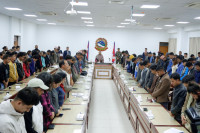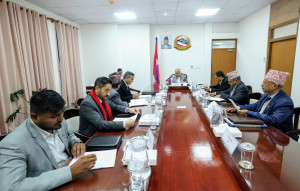Columns
Missing Nepali women
The government must address the harmful effects of protectionist policies.
Ayushman Bhagat, Sulochana Khanal & Sangita Nepali
Rama (name changed) left her home in 2012 to work as a domestic worker in Kuwait. She migrated to support her family. For years, she sent regular remittances and assured her mother that she was safe. Then, on August 9, 2015, she made her last call and told her mother that she was planning to leave soon and would send some things home. Eleven years later, her mother still waits, raising Rama’s children without knowing if her daughter is alive or dead.
Rama’s story is heartbreaking, but sadly, quite common. Every year, thousands of Nepalis go missing. Official data shows over 60,948 people went missing between 2019-20 and 2023-24. The reasons for their disappearance include, but are not limited to: domestic violence, mental health issues, trafficking and exploitation, natural disasters and voluntary disappearance.
Of the total, 26,770 (around 44 percent) reported cases were of women. Whilst the reasons mentioned above do play a role in their disappearance, many cases go unreported due to the protectionist policies of Nepal. Bans on domestic work emigration and refusal to recognise sex workers as workers with rights are two examples of such policies.
Our research, activism and grassroots experiences demonstrate that restrictions and stigma around sex work and domestic work drive women towards clandestine routes and make it difficult for their family members to seek help.
The protectionist policies create such conditions under which thousands of Nepali women go missing. Therefore, the number of missing Nepali women could be significantly higher than the reported statistics.
Emigration bans and missing women
In 2017, the Government of Nepal banned foreign employment in domestic work. In 2020, the government imposed seven preconditions for allowing foreign employment in such work, which some argue further strengthened the ban. The ban is further cemented by restrictive measures like NOC requirements, reluctance to issue visit visas, anti-trafficking transit monitoring, surveillance at highways, borders and airports and anti-migration initiatives in villages.
These bordering practices have not stopped Nepali women from emigrating for domestic work. Many of them use irregular channels. Modest estimates suggest between 60,000 to 100,000 Nepali women work abroad in the sector.
Many women migrating for domestic work have a positive experience and contribute to society via remittance. Despite this, several migration and anti-trafficking actors often sensationalise negative stories of domestic work migration, thereby legitimising bans based on unfounded assumptions of widespread exploitation.
As a result, several Nepali women are not recognised as migrant workers by the government. It leaves them with no protection when they face exploitation in destination countries.
Family members consider these women as missing unless they call home—sometimes after months or never. Research shows that agents sometimes pay family members and involve them in illicit migration. As a result, several families cannot report women as missing for fear of trafficking accusations. Hence, emigration bans on domestic work push women into clandestine routes and punish families who seek help when they go missing.
The stigma of sex work
Sex work has been a long-standing issue in Nepal. Several actors in Nepal are reluctant to accept that more than 200,000 Nepali women are working as sex workers in India, and between 28,000 and 50,000 in Nepal. Nepal’s anti-trafficking legislation classifies them as victims of trafficking and subjects them to harmful anti-trafficking practices. Anti-trafficking NGOs use sensationalised stories of sex trafficking to legitimise harmful practices that exaggerate inaccurate data.
For example, the data claiming that every year 5,000 to 7,000 women and girls are trafficked to India for sex work is outdated and inaccurate. This baseless estimate first appeared in 1986 and has since been exploited as a sensationalist statistic to legitimise and expand Nepal’s anti-trafficking industry.
The industry’s focus on ‘rescue’ and ‘interception’ ignores women’s choices and experiences. It treats them as victims rather than workers with rights. In doing so, it brands them as ‘trafficked’, imposing a lasting stigma on their bodies, labour, mobility and communities.
Yet, anti-trafficking offers no easy way for ‘trafficked victims’ to reintegrate into their societies or get rid of the label. This stigma strips them of dignity and deters many from seeking help. As a result, several returnee women hide their sex work experience due to stigma.
Victims of protectionist policies
Protectionist policies related to labour and mobility in sex work and domestic work in Nepal create conditions that contribute to the prevalence of missing women. To address this issue, Nepal must uphold the labour and mobility rights and recognise the lived experiences of all Nepali migrant women. This requires lifting emigration bans on domestic work and establishing legally binding and enforceable labour agreements to protect Nepali women working abroad.
We recommend that the government recognise all domestic workers abroad by unconditionally registering them with the embassies and consulates. As vital is including an anti-trafficking clause in Bilateral Labour Agreements (BLAs) to compel countries to uphold the rights of exploited Nepali women by providing safe accommodation, legal protection, free support services and the right to remain, either temporarily or permanently. We also call for the decriminalisation of sex work.
The government must acknowledge women engaged in sex work as workers. It should immediately change anti-trafficking policies that conflate sex work with sex trafficking and take steps to abolish harmful anti-trafficking measures. Trade unions must organise sex workers, and civil society must advocate for decriminalisation.
There is a need for critical reassessment of the Indo-Nepal Peace and Friendship Treaty. The government should recognise Nepali workers in India as legitimate labour migrants, raise the issue of labour exploitation of its citizens in India and make provisions to ensure the right to safe and healthy employment.
We must recognise Nepali migrant women as workers with rights and dignity, not as criminals or victims. The government must urgently take measures to address the damaging effects of protectionist policies that cause women to disappear. Without these changes, the disappearance of Nepali women will continue, leaving families like Rama’s suspended between despair and hope.




 8.12°C Kathmandu
8.12°C Kathmandu

















